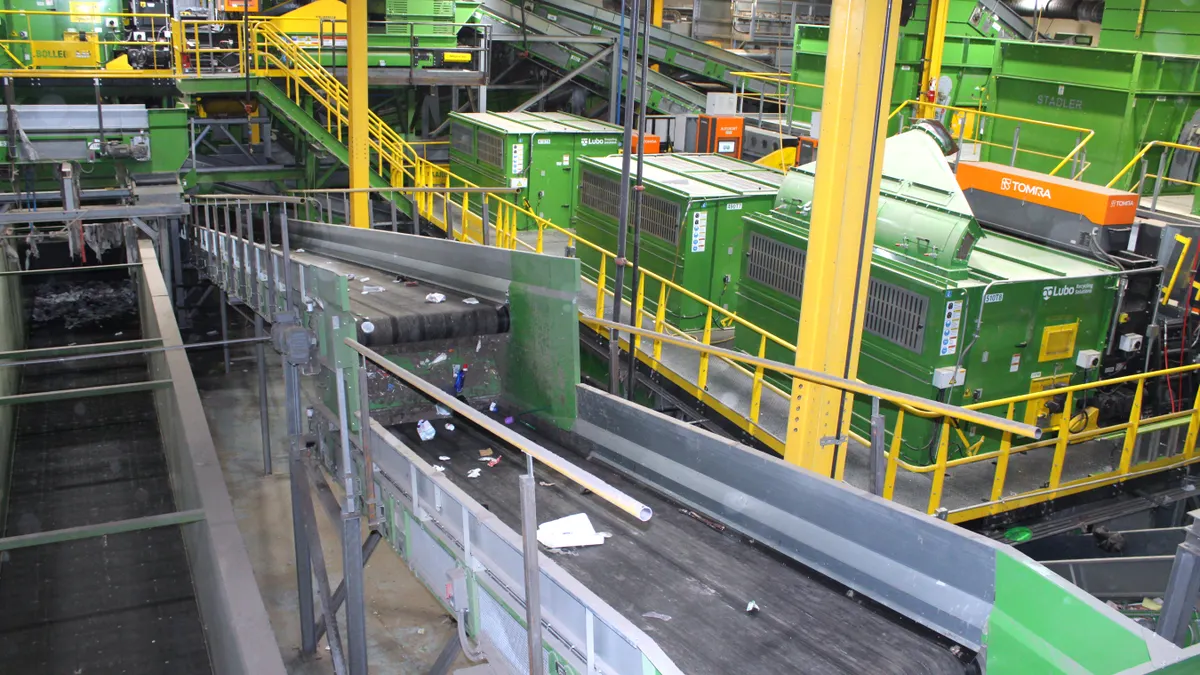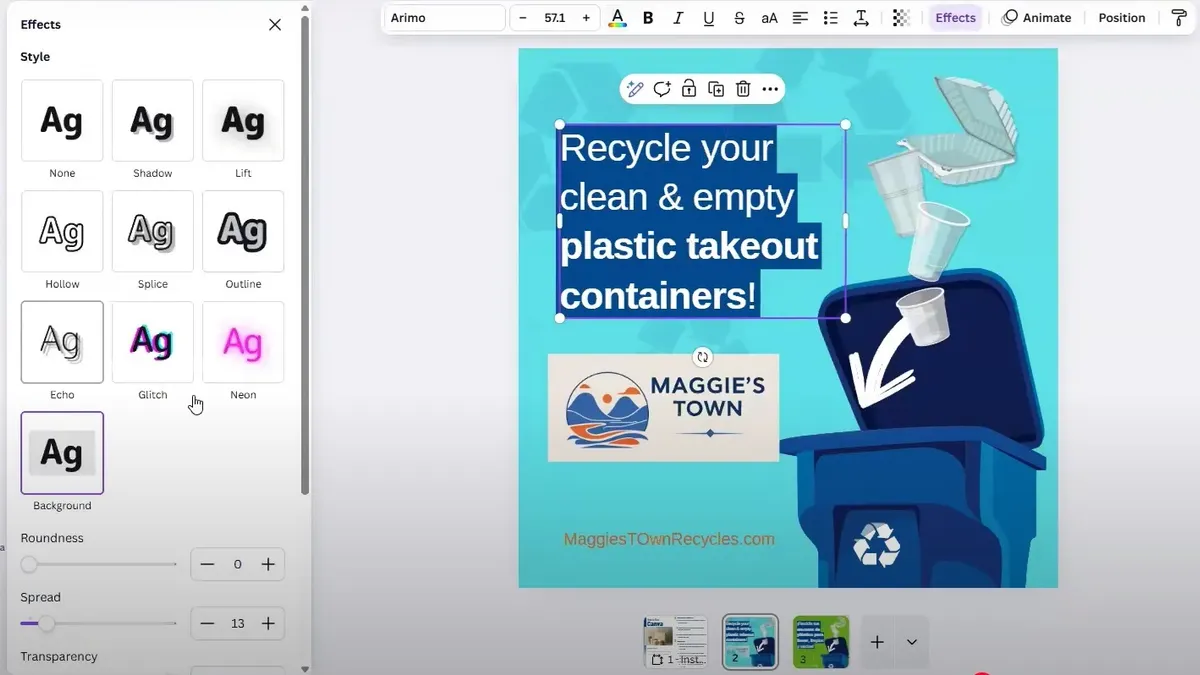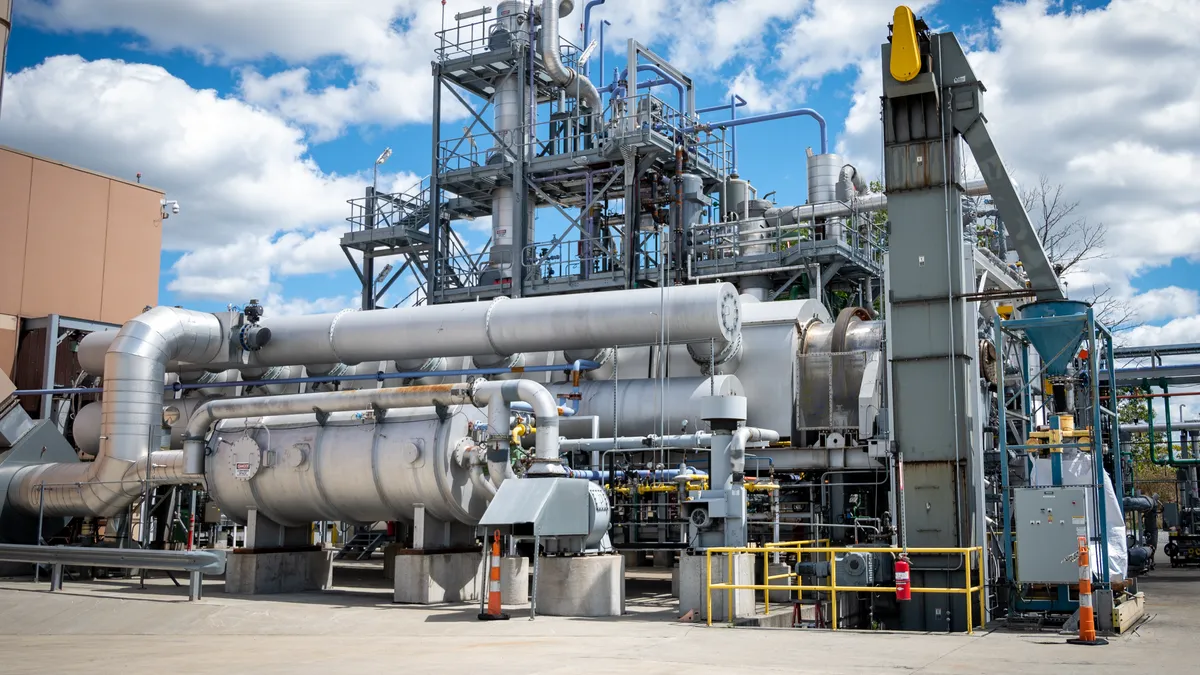It’s been five years since China’s National Sword policy rocked the global trade of recycled commodities. The significant investments North American MRF operators have made in its wake are expected to continue.
National Sword was a major force for growing domestic markets and spurring infrastructure investment. But more recent factors — such as changing recycling streams, state recycling mandates, brand commitments and labor challenges — are driving MRF operators forward in getting curbside recycling materials cleaner and more valuable to U.S. buyers, experts say.
“National Sword was a big shock to our industry,” said Bill Keegan, president of Minnesota-based Dem-Con, a company that started its residential recycling MRF in 2013. When China’s policy took effect in 2018, many MRFs that had been exporting most of their material found themselves with stockpiles they couldn’t find buyers for, and it took several years to course-correct.
That led to a major shift in processors connecting to domestic destinations for recycled materials, and those domestic markets have since grown steadily. “I don't think that change would have happened organically without China changing their policies,” he said.
While MRF operators had already been investing in new equipment, the onset of National Sword greatly accelerated the process and gave them a clear focus: quality, quality, quality.
National Sword, past and present
China’s National Sword policy, which officially took effect in 2018, banned the import of many types of scrap into the country, including mixed paper and mixed plastics. The remaining imports had to clear a 0.5% contamination level.
In 2018, China made up about half of the global demand for many recycled commodities. One immediate effect of National Sword was a traffic jam for mixed paper, which temporarily overflowed in U.S. markets. For a time, some MRFs had to stockpile the material, or even bury it.
“We started seeing the price of mixed paper go down to literally negative numbers — negative $5, negative $10,” Keegan said. Markets for some postconsumer plastics also had dismal prices and logjams.
Keegan considers Dem-Con lucky. In 2018, it was already doing about 70% of its business domestically, meaning the company could leverage existing relationships to funnel more of its material to those partners while spending time looking for new end markets. The market in Minnesota was already less reliant on selling into international markets because of the cost to ship materials to the coasts, he said. Still, new competition was fierce.
“It was a tough time, but eventually things began to settle again,” he said.
In the early days, many MRF operators found themselves competing for limited markets, meaning they had to use existing equipment to create the cleanest bales possible. In some cases, that meant slowing down sorting lines to reduce contamination, said Cody Marshall, chief of community strategy at The Recycling Partnership.
“Slowing down hurts throughput, but over time we started seeing more equipment come online, specifically on paper lines, to focus specifically on quality,” he said.
Dem-Con spent about $2 million in 2018 as a direct result of National Sword. The MRF added two optical sorters to clean up its fiber line.
“We knew we could no longer have 2% fiber contaminated fiber — we need to have half a percent and we needed it at production speeds,” Keegan said.
The MRF has continued to invest in improvements in the years since, including a new polypropylene optical sorter in 2021. The company is planning to add another robot from AMP Robotics, which supplies AI-powered sorters to large and small waste and recycling companies, next month.
Marshall says many MRFs made big investments in the wake of National Sword, but that wasn’t the only driving force. The composition of the curbside recycling stream was already changing, with the rise of e-commerce adding more OCC to the stream and the decline of print newspapers subtracting that material. Some MRF operators also wondered if the years-long shift from dual stream to single-stream recycling was partly to blame for quality issues.
Recent MRF investments have focused more on the “evolving ton.” For example, Firstar Fiber in Omaha added another optical sorter to remedy an issue where flattened boxes obscured bottles and cans on the belt. Boxes were also getting smaller, which some equipment may not handle well. The COVID-19 pandemic, which created further OCC demand and added more to curbside streams as people stayed at home in the early months, could shape even further fiber line enhancements.
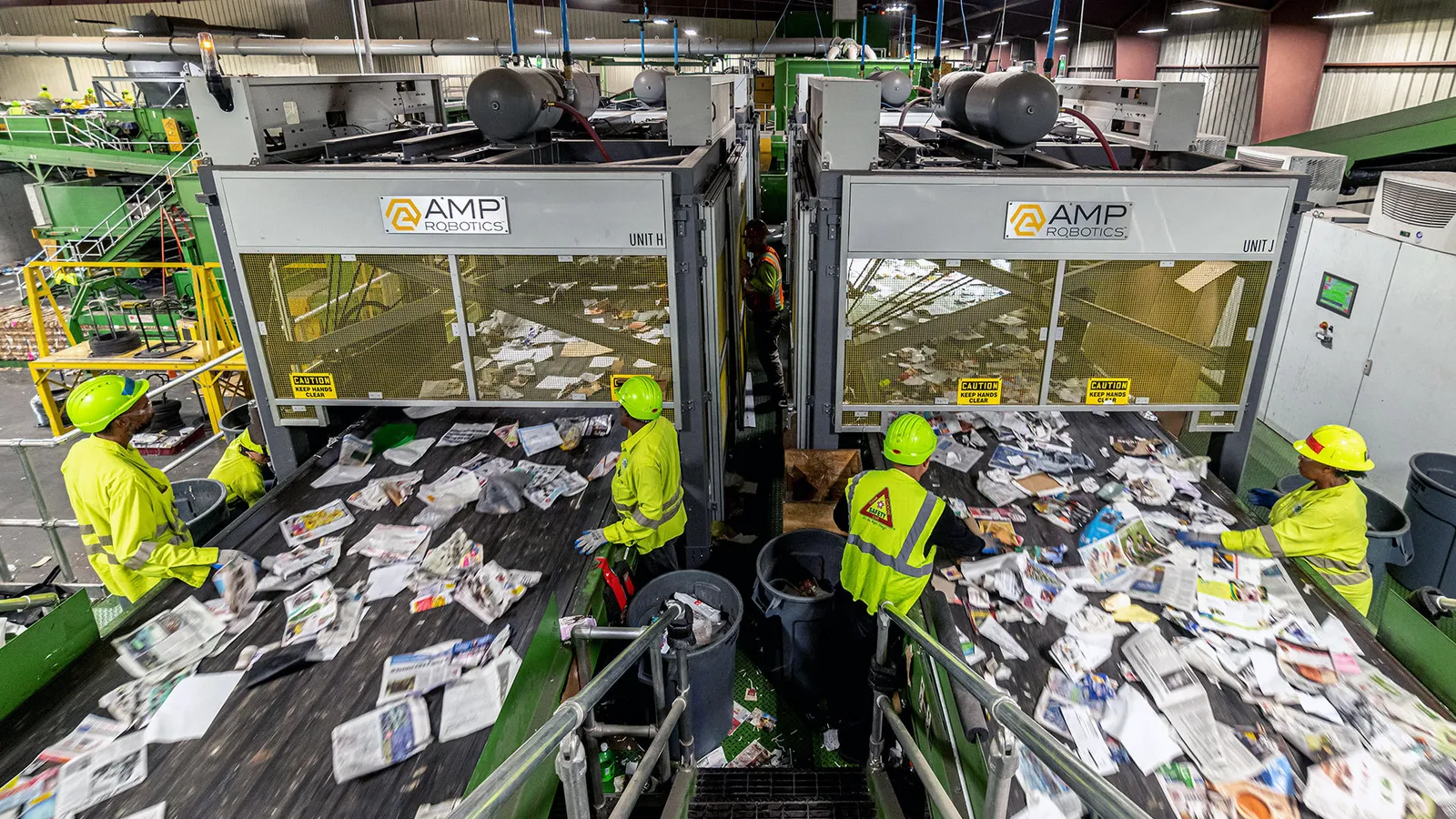
MRF investments: Current trends
Another change since 2018, though not specifically related to National Sword, is that the price and availability of some MRF equipment is becoming more attainable, with robotics in particular becoming “less cost prohibitive,” said Jennifer Louie, executive director of Closed Loop Partners’ infrastructure group.
MRF operators were already struggling to hire and retain workers before National Sword because of high turnover in sorting jobs that can be dirty and dangerous. Robots may have been somewhat of a novelty in 2017, but today the industry sees them as a critical investment worth expanding or even redesigning their MRFs to accommodate, experts say.
Waste Connections, currently the largest of AMP’s customers, has either booked or installed 50 robotic systems from the company. GFL Environmental, Republic Services, WM and other major MRF operators have made similar investments.
In addition to implementation of robotics, WM has made other automation improvements in the last five years in an effort to cut labor costs and continue improving commodity values. It has since overhauled at least six facilities with automation in mind, saying a focus on robotics and other automation will reduce labor by 30%. It plans to phase out an estimated 1,200 MRF positions through attrition in the coming years retrain existing employees to integrate their work into the new automation-focused vision.
Meanwhile, Casella Waste Systems is investing $20 million in the modernization of its Boston MRF, with most of the funding going toward the purchase of robotics equipment that will replace jobs often done by temporary workers. It plans to spend an additional $1 million on other robotics projects.
Optical sorters have continued to play an important role as a MRF upgrade, oftentimes alongside parallel investments in AI and robotics. As a team, the equipment can be a powerful quality assurance tool and a method to gain more granular data on the material moving through their facilities, Louie added.
“What we've seen is an even greater interest from our operators in exploring and embracing the power of data, so there’s lots of interest around waste recognition and analytics platforms,” Louie said. “One of the reasons why so many of these operators are starting to explore this is because it allows them to have tangible evidence that measures the quality of their bale — it’s to their advantage.”
Having access to such data helps reinforce the lesson many in the recycling industry learned during National Sword: Quality is king. Facilities that can keep quality up and costs down may stay ahead in future bouts of market uncertainty, Keegan said.
The first few months of 2022 saw “fantastic” commodity prices and high demand, but prices have since fallen significantly.
“MRFs today are generally still focused on quality, but when pricing is great and you can get a bunch of volume through, quality might take a backseat to demand,” Marshall added. “It's important to stay focused on the importance of consistent, good quality feedstock, no matter what the market price is doing at any given time.”
Creative funding solutions
Though higher-tech sorting equipment is becoming more available and attainable, such systems are still expensive, especially for smaller recyclers. At the same time, the options MRF operators have for financing their newest equipment have also expanded in recent years, said Chris Wirth, vice president of marketing, business development and government affairs for AMP.
“The biggest difference from before National Sword is the diversity of ways you can fund technology, especially in the last 18 months to two years where a lot more industry dollars are subsidizing infrastructure,” Wirth said.
The Infrastructure Investment and Jobs Act passed in November 2021, allocating $275 million to states, territories and tribal governments for projects like municipal recycling program improvements and upgrades to local waste management systems.
Though state funding, public grants and federal funding are all options, “we have seen a much greater proliferation of brand-backed coalitions like [The Recycling Partnership] or the Can Manufacturing Institute that drive these recent investments,” Wirth said.
Brand commitments that were just getting off the ground in 2018 are becoming an increasingly influential market driver, along with new state laws requiring brands to use more recycled content, Wirth said.
Another shift has been the increasingly direct role of certain investors in the ownership of facilities themselves. Closed Loop announced in 2019 that its new Leadership Fund would purchase a majority stake in Texas-based recycler Balcones Resources. In 2020, Balcones acquired Single Stream Recyclers in Sarasota, notable for the operation’s major investment in robotics. Closed Loop also acquired Sims Municipal Recycling, operator of a major New York City facility, earlier this year.
“Closed Loop getting into the operator game as a competitor to others in the industry continues to drive demand, just using a different business model,” Wirth said.
MRF operators have also found success funding their equipment through state business incubator programs such as NextCycle, which operates in Colorado, Michigan and Oregon.
MRFs are also finding more opportunities to lease equipment. AMP announced its own leasing program in May 2020, which Wirth said is meant to help MRFs free up cash needed to invest in other parts of the business. Meanwhile, publicly owned MRFs or other businesses that can’t scale up as quickly as private companies, as well as municipalities, could continue recycling services during budget shortfalls or economic downturns.
Some examples include a Glass Packaging Institute leasing program that pays for equipment upfront. The Can Manufacturers Institute offers a similar program for can sorting equipment.
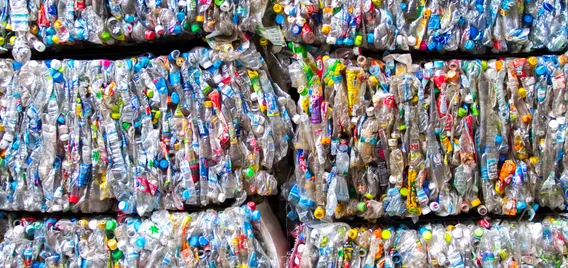
The next 5 years
National Sword may have shaped the way MRFs operate, but experts say brand commitments, state laws and other factors will drive MRF investments in the next five years.
“We see ourselves in what I would call a post-transition away from China, where those domestic end markets and other problems are normalizing,” Keegan said. “Now we’re getting hit with a pandemic and policy and supply chain disruptions.”
The industry still faces challenges attracting people to recycling jobs, a problem that may be remedied not just with robotics investments but by offering higher wages or clearer pathways to promotions, or by connecting to workers who are military veterans or have criminal records.
At the same time, MRFs that have scheduled new equipment deliveries are facing multi-month delays because of global supply chain disruptions. In turn, that could cause a longer-term impact on the infrastructure needed to fulfill recycled content commitments from major brands.
The pandemic paused some of the recycling industry’s efforts to expand curbside access, recycle more types of materials and hire employees to increase MRFs’ operating capacity, Wirth added, but he predicts that will change soon. “There will be a cascade of infrastructure as we start reactivating curbside programs, capturing rural recycling and bringing on more materials,” he said.
Wirth sees new laws like California’s SB 54, widely considered to be the nation’s most comprehensive paper and packaging producer responsibility policy, as a major market influence.
“There’s going to be more and more infrastructure beyond what we already have — and we’re going to need all of it to meet PCR goals of brands and demands from the regulatory environment in places like California. And more states will pass laws raising diversion goals and establishing extended producer responsibility programs,” he said.
Keegan said he sees hope for future domestic markets that wasn’t there in the beginning days of National Sword. Brand owners that announced recycled content commitments back then weren’t being as proactive as they are today, he said. Now, the conversations are about how to create packaging that’s not just recyclable in common MRF systems, but part of a larger circular economy vision.
“We’ve been lucky lately to have conversations with brand owners about this,” he said. “For the first time they're really reaching out and saying, ‘Hey, how can we try to meet our goals and your goals for recyclability?’ And so it's a refreshing conversation that hadn't happened historically. It's happening now quite a bit.”









